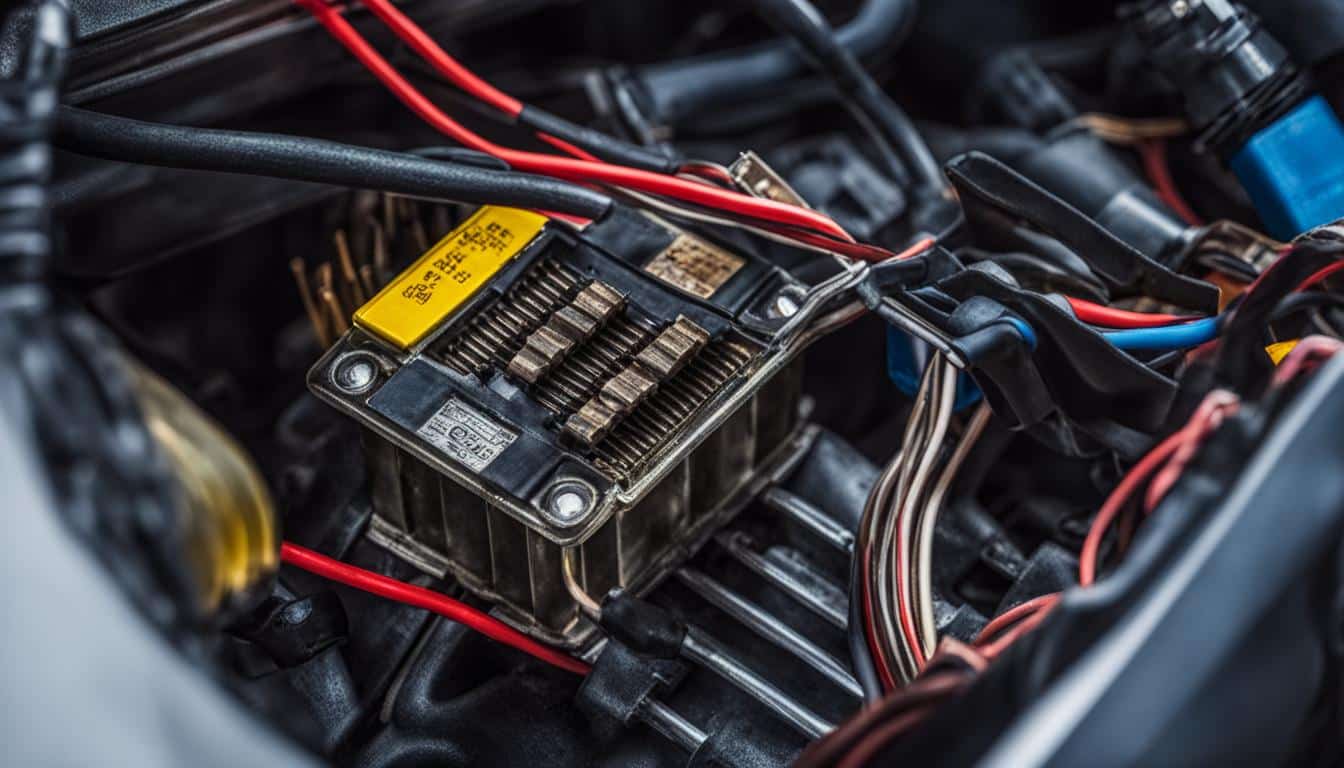
Essential Guide to Car Fuses: Maintenance and Troubleshooting
Car fuses are an essential component of a vehicle’s electrical system, playing a vital role in ensuring both functionality and safety. They act as silent guardians, protecting sensitive electronic components from potential damage caused by overloads or short circuits. Understanding the different types of fuses, knowing when to replace them, and practicing proper electrical safety measures are crucial for every car owner.
Key Takeaways:
- Car fuses are crucial for maintaining electrical safety in vehicles.
- They act as safety nets, protecting the electrical network and sensitive components.
- Regularly checking fuses can prevent larger electrical problems and ensure a smooth ride.
- Fuse boxes can be located under the dashboard, in the glove compartment, or beneath the hood.
- Proper fuse replacement and testing techniques are essential for maintaining a healthy electrical system.
The Importance of Checking Fuses

When it comes to maintaining a vehicle’s electrical system, checking fuses plays a crucial role. Fuses act as circuit breakers, preventing potential electrical malfunctions and protecting sensitive components. One of the primary reasons for checking fuses is when a fuse blows, which can happen due to a variety of factors such as overloads or short circuits. By regularly inspecting and replacing blown fuses, car owners can ensure the smooth operation of their vehicle’s electrical functions.
Checking fuses is especially important when certain electrical components malfunction. If, for example, a specific light or accessory stops working, it could be a sign of a blown fuse. By investigating and addressing the issue promptly, car owners can prevent larger problems from arising. Additionally, before embarking on a long journey, it is advisable to check the fuses to ensure all electrical systems are functioning correctly, avoiding potential issues during the trip.
To incorporate fuse checks into regular vehicle maintenance routines, it is essential to familiarize oneself with the location of the fuse box. Different car brands and models have unique fuse box locations, which can be found under the dashboard, in the glove compartment, or beneath the hood. The owner’s manual serves as a valuable resource for identifying the specific location. By knowing the fuse box’s whereabouts, car owners can efficiently access and inspect the fuses when needed.
Overall, understanding the importance of checking fuses is vital for maintaining a healthy electrical system in a vehicle. Regular inspections can detect blown fuses, preventing potential electrical malfunctions and ensuring the proper functioning of various components. By taking the time to inspect, replace, and address any electrical issues promptly, car owners can enjoy a smooth and trouble-free driving experience.
Finding the Fuse Box
When it comes to checking and replacing car fuses, one crucial step is locating the fuse box. Each car brand and model has a unique placement for the fuse box, which can typically be found in three main locations: under the dashboard, in the glove compartment, or beneath the hood. To identify the exact location, car owners can refer to the owner’s manual, which serves as a helpful guide.
Under the dashboard is a common placement for the fuse box. It is usually located on the driver’s side, near the steering column. This location offers easy accessibility, allowing car owners to quickly inspect and replace fuses if needed. Another frequently used location is the glove compartment. Some car models have the fuse box conveniently tucked away inside the glove compartment, providing a neat and organized solution. Lastly, some vehicles have the fuse box positioned beneath the hood, near the engine. This location is typically reserved for larger fuses that are linked to essential functions of the vehicle.
Understanding the location of the fuse box is essential for efficient troubleshooting and maintenance. It allows car owners to identify and address electrical issues promptly. Whether it’s a blown fuse or a malfunctioning electrical component, knowing where to find the fuse box ensures a smoother diagnostic process. By familiarizing themselves with the fuse box’s location, car owners can confidently navigate the world of car fuses and maintain a healthy electrical system.
Step-by-Step Guide to Checking Fuses
When it comes to checking fuses in your car, safety should always be the top priority. Before starting the process, make sure to turn off the car to avoid any potential electrical hazards. It’s also a good idea to wear protective gloves to prevent any injuries. Once you’ve taken the necessary safety precautions, follow these steps to effectively check your car’s fuses.
1. Gather the Required Tools
To check your fuses, you’ll need a few essential tools. A fuse puller or tweezers will help you safely remove the fuses without causing any damage. Additionally, a flashlight is crucial for proper illumination while inspecting the fuse box, as it may be located in a dark or tight space. Lastly, consider using a multimeter for thorough diagnostics, although it’s an optional tool.
2. Locate the Fuse Box
The next step is to locate the fuse box in your car. Refer to the owner’s manual to find the specific location, as it can vary depending on the make and model of your vehicle. In most cases, the fuse box is usually found either under the dashboard, inside the glove compartment, or beneath the hood.
3. Inspect the Fuses
Once you’ve located the fuse box, use the fuse puller or tweezers to carefully remove each fuse. Take a close look at each fuse to check for any signs of damage, such as a broken filament or discoloration. If you’re using a multimeter, you can also test the fuses for continuity to determine if they are functional or blown.
4. Replace Blown Fuses
If you find a blown fuse during the inspection, it’s important to replace it with a new one of the same amperage rating. Refer to the owner’s manual to identify the appropriate rating for each fuse slot. When inserting the new fuse, ensure it fits securely and snugly into place. This step is crucial for maintaining proper electrical function in your car.
| Fuse Type | Amperage Rating | Usage |
|---|---|---|
| Main Fuse | 30A | Protects the main electrical system of the car |
| Headlight Fuse | 15A | Controls the headlights and related components |
| Radio Fuse | 10A | Power supply for the car’s audio system |
| Accessory Fuse | 20A | Supports various accessories such as power windows and mirrors |
By following these steps and taking the necessary precautions, you can effectively check the fuses in your car and ensure the electrical system is functioning properly. Regular fuse inspections and prompt replacement of blown fuses can help prevent larger electrical issues and keep your vehicle running smoothly.
Replacing Fuses and Testing with a Multimeter
When a blown fuse is identified, it is crucial to replace it with a new one of the same amperage rating. This ensures that the fuse can handle the electrical load properly. The amperage rating can be found in the owner’s manual or on the fuse box cover. It is important to note that using a fuse with a higher amperage rating can lead to electrical damage and potential safety hazards.
To replace a fuse, follow these steps:
- Turn off the car’s ignition and make sure all accessories are powered off.
- Locate the blown fuse in the fuse box.
- Using a fuse puller or tweezers, carefully remove the blown fuse from its slot.
- Insert the new fuse into the vacant slot, ensuring a snug fit.
- Turn on the car’s ignition and test the electrical component associated with the replaced fuse to ensure proper functionality.
After replacing a fuse, it is recommended to test its functionality with a multimeter, especially if the cause of the blown fuse is unknown. Set the multimeter to the continuity mode, which allows you to check if the fuse is still intact. Touch the multimeter probes to the metal tabs on both ends of the fuse. If the multimeter indicates continuity, the fuse is functional. If there is no continuity, the fuse may be defective or there may be an underlying electrical issue that requires further investigation.
Example Table: Fuse Amperage Ratings
| Fuse Amperage | Recommended Applications |
|---|---|
| 10A | Interior lights, dashboard lights, audio system |
| 15A | Power windows, door locks, windshield wipers |
| 20A | Headlights, fog lights, air conditioning |
| 30A | Power seats, power sunroof, electric fans |
It is essential to consult the owner’s manual for the specific fuse amperage ratings in your vehicle, as they may vary for different makes and models. Ensuring proper fuse replacement and testing with a multimeter can help maintain a safe and functioning electrical system in your car.
Tips for Maintaining a Healthy Electrical System
Regular fuse inspections are essential for maintaining a healthy electrical system in your vehicle. By periodically checking your fuses, you can identify and address any potential issues before they escalate into larger electrical problems. It is recommended to include fuse inspections as part of your regular vehicle maintenance routine to ensure optimal performance and prevent unexpected electrical failures.
Addressing electrical issues promptly is another crucial aspect of maintaining a healthy electrical system. If you notice any abnormal behavior or malfunctioning electrical components in your vehicle, it is important to take immediate action. Ignoring electrical problems can lead to further damage and potentially unsafe conditions. By addressing these issues promptly, you can prevent further complications and ensure the safety and reliability of your vehicle’s electrical system.
Properly labeling fuse compartments can significantly assist in troubleshooting electrical problems. When a specific electrical component malfunctions, having clearly labeled fuses can help you quickly identify and locate the corresponding fuse. This can save you time and effort while diagnosing and resolving electrical issues. Take the time to label your fuse compartments accurately to streamline the troubleshooting process and make it more efficient.
Regular fuse inspections, addressing electrical issues promptly, and properly labeling fuse compartments are all key practices for maintaining a healthy electrical system in your vehicle. By incorporating these tips into your routine maintenance, you can ensure the longevity and reliability of your vehicle’s electrical network, preventing future problems and ensuring a smooth and safe driving experience.
Conclusion
Car electrical problems can be frustrating and disruptive, but with the right troubleshooting techniques, many issues can be resolved at home. By understanding the basics of car fuses and how to check them, car owners can tackle common electrical problems and ensure the smooth operation of their vehicles.
However, there are instances where professional help is necessary. Persistent electrical issues or complex electrical systems may require the expertise of a trained technician. It’s important to recognize when it’s time to seek professional assistance to avoid further complications.
To prevent future electrical problems, regular maintenance and inspections are key. By incorporating routine fuse checks into vehicle maintenance routines and addressing electrical issues promptly, car owners can maintain a healthy electrical system and minimize the risk of future problems.
Remember, an electrical system is the lifeblood of a vehicle, and understanding how it works and maintaining it properly can ensure a smooth and trouble-free driving experience. By staying proactive and proactive, car owners can drive with confidence and enjoy the reliability of their vehicles for years to come.

FAQ
Why is it important to check fuses?
Checking fuses is important because when a fuse blows, it cuts off the circuit, preventing potential surges or malfunctions from reaching sensitive components.
Where can I find the fuse box in my car?
The fuse box in your car can be located under the dashboard, in the glove compartment, or beneath the hood. Consult your owner’s manual for the exact location.
How do I check fuses in my car?
Before checking fuses, it’s important to turn off the car for safety. You can use a fuse puller or tweezers to remove fuses without damaging delicate components. A flashlight is essential for proper illumination while inspecting the fuse box’s crevices. Optionally, a multimeter can be used to confirm whether a fuse is blown or not.
How do I replace a blown fuse?
When a blown fuse is identified, it should be replaced with a new one of the same amperage rating. The owner’s manual indicates the appropriate rating for each fuse slot. Proper placement and a snug fit are essential.
Can I test the functionality of a new fuse?
Yes, you can use a multimeter set to the continuity mode to confirm the functionality of the new fuse.
How can I maintain a healthy electrical system in my car?
Regularly incorporating fuse inspections into vehicle maintenance routines can prevent larger electrical issues. Addressing electrical problems promptly is important to avoid escalation. Properly labeling fuse compartments can make troubleshooting quicker and more efficient.
When should I seek professional help for car electrical problems?
While many car electrical problems can be resolved at home, there are instances where professional intervention is necessary, such as persistent electrical issues or complex electrical systems.
